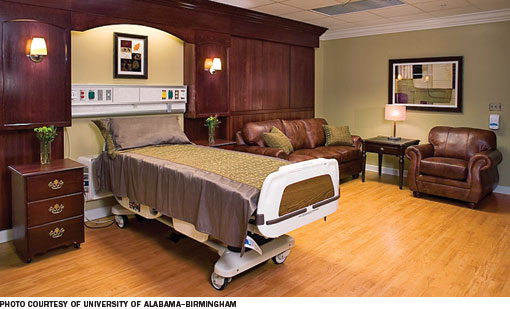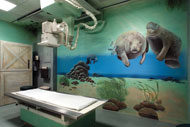About this articleThis feature is one of a series of quarterly articles published by Health Facilities Management magazine in partnership with the American College of Healthcare Architects. |
There is a vacant unit on the fifth floor of a 200-bed inpatient facility. Administration has informed the facility management department that it will be reopened to provide palliative care. What is the best way to accomplish this? That is a question that health facilities professionals are facing or soon will be asked to address to improve patient care and reduce health care costs.
The World Health Organization (WHO) defines palliative care as "an approach that improves the quality of life of patients and their families facing the problems associated with life-threatening illness, through the prevention and relief of suffering by means of early identification and impeccable assessment and treatment of pain and other problems — physical, psychosocial and spiritual."
The Dartmouth Institute for Health Policy & Clinical Practice reported in 2011 that one-quarter of all Medicare spending was for care to patients in the last year of life. If, by implementing palliative care services, patient and family satisfaction can be achieved along with financial savings, the addition of a palliative care unit (PCU) will become a necessity.
Patient and family
Over the past 30 years, there has been a trend toward patient- and family-centered care that has created alterations in the way health care has been provided. Patient moves have been decreased and rooms have become less institutional and more homelike in appearance with soothing colors, fabrics and furnishings.
During this same period, palliative care began to evolve. Generally speaking, it comes after the high activity involved in seeking a cure or reversing a disease and the frequent transport of the patient to various departments for diagnostic testing and treatment. However, even though disease treatment may have halted, care continues and can increase exponentially to encompass all aspects of the WHO's definition.
Palliative care teams can be found in large hospitals working in oncology, pediatrics, emergency and intensive care. A stand-alone PCU, on the other hand, is distinguished from the hustle and bustle of these traditional types of inpatient units.
In hospitals with PCUs, the palliative care physician is called to engage with a patient in the emergency department or the intensive care unit. The physician will invite the patient to be transferred to the palliative care unit and, once there, the palliative care team will work with the patient to customize a plan based upon that patient's goals of care, developed through discussions with the palliative care team, the patient and family. The patient and family set up temporary residence in the assigned palliative
care room.
A large part of the care plan will include symptom control and pain management as well as counseling. Many patients are transferred to the PCU for de-stressing before being relocated back to their home or to another location. It can provide both the critically ill patient and family the respite they need as they prepare for the next step in their journey.

Palliative environments
Depending upon the facility, creating a PCU will require the remodeling of an existing space or the creation of a new one. In either case, the physical environment will influence the success of the unit in concert with the health care practitioners who work in it.
The location of the PCU within the hospital is critical and a quiet space with natural lighting is preferable. If the PCU's patient rooms are located next to a busy street, it will be difficult to separate those spaces from the uncontrollable sounds outside.
When evaluating an existing space for remodeling, pay attention to how its interior affects the senses. Does it look old? Does the millwork need to be repaired or replaced? How much natural light does it receive? How soundproof are the interior walls? Is the HVAC system noisy? Do the air handling units give off a musty smell or is there movement of fresh air?
Environments for effective delivery of palliative care encompass patient rooms as well as the hallways, nurses' stations and gathering areas that serve the PCU's patient rooms.
The goal for the rooms is to create a homelike environment as much as possible, not unlike a single-room maternity suite. In areas outside the rooms, the aesthetic should approach the clean, uncluttered simplicity of a spalike setting.
Wall and floor colors as well as the furnishings, lighting and artwork should be chosen not only for utility, but also to increase a sense of calm and comfort for both patient and family.
Noise within the unit must be excluded as much as possible. From the nurse call and paging systems to the beepers on equipment, the cacophony must be minimal.
Key components
To evaluate existing spaces or to design new ones for palliative care, the health facilities professional will find a checklist of key components necessary. From this analysis, a space plan can be formulated for an efficient and effective unit. These components include:
The patient room. Private rooms measuring 150 to 200 square feet are recommended. If converting semiprivate rooms to private rooms during an inpatient unit renovation, there must be ample space for the patient bed, sleeper sofas, chairs and other comfortable furniture choices.
• Natural light. Natural light in every room is essential because it contributes to the patient's feeling of well-being and connectedness.
• Light fixtures, clocks and Internet access. Each room should have table and ceiling fixtures that are residential in appearance along with nightlights and luminous clocks. Task-specific lighting should also be included to support around-the-clock care. Internet access is important in every patient room for both patient and family.
• Floor and ceiling finishes. Finishes that are residential in character are preferable, but can pose a challenge. Carpet, which absorbs sound, can be difficult to keep clean. Carpet tile improves the ability to keep floors clean, but is more expensive and often appears commercial or institutional. Resilient floors are not as sound-absorbent, but are easier to maintain. Wood plank-looking sheet vinyl works well, meets clinical maintenance requirements and can project an informal homelike feel. For ceilings, lay-in acoustical panels are effective at controlling sound, but are institutional in appearance. Thus, concealed spline ceilings are recommended.
• Artwork. Artwork should be pleasing to a broad range of ages and complement the homelike environment. Pieces in patient rooms should be located so that patients can enjoy them. Art pieces in the work and public spaces likewise should be complementary to the overall interior design.
• Televisions and stereo systems. For patient rooms, easy-to-operate flat-screen televisions and good stereo systems are strongly recommended. Music is essential for masking sound and inducing relaxation.
• Hospital-based electronic systems. Customizing the options on the PCU nurse call and paging systems is important. Beeps and flashing lights are detrimental to the character of a homelike environment.
• Patient and family storage. If allowed by the facility, under-counter refrigerators and storage for food is helpful for families staying with the patient. General storage for family belongings is also very important as their active involvement brings many of their essential possessions, including computers and books and other time-consuming electronics.
Toilet room. En suite patient toilet rooms should include nonslip flooring, roll-in showers and elevated toilet seats with adjacent grab barsfor easy transfer from wheelchairs or walkers. In most cases, the shower will be used by the family rather than the patient, but installing grab bars still is recommended.
Staff space. A palliative care team is large and there must be space for collaboration among team members, such as a conference room. The team will include a physician, nursing staff, chaplain and social workers, and might grow to include staff who provide recreational therapy and even massage therapy. In a remodeling project, this may necessitate removing patient rooms and reconstructing them as staff conference rooms or other work spaces.
Unit storage. Adequate space for clinical and other equipment storage is essential and should be located outside the patient rooms. This saves steps and secures the equipment when not in use. It also keeps the equipment from visually dominating a patient's room.
Gathering room. A gathering room for patients' families should be included. Likewise, a consult room for family meetings with medical staff is essential. These spaces should be in direct view of the main nursing control desk area. The gathering room should be as large as possible and flexible enough to function in numerous capacities, because it will be used by many throughout the life of the unit. Noise transmission also must be considered and these spaces should have an acoustical ceiling.
Outdoor space and indoor air. Outdoor space accessible to the patient and family is an advantage in a PCU. Access to fresh air via an open balcony or an outside garden has been shown to improve a patient's well-being. High-quality air moving through mechanical systems, however, is satisfactory if it can be controlled in each patient's room.
Expense no barrier
A high-quality PCU is not defined by expensive new construction costs. Many hospitals already have empty semiprivate rooms that could be converted easily into palliative care rooms.
Rather, the facility professional must create a space specifically for palliative care where palliative care professionals will lead the effort to make the area function as a place where patients will want to stay until it is time for them to leave.
Connie McFarland, FAIA, FACHA, LEED AP BD+C, is president and owner of McFarland Architects, a 25-year-old firm based in Tulsa, Okla. She can be contacted at connie@mcapc.com.
| Sidebar - Palliative care + patient satisfaction |
| Health care organizations are starting to understand that many seniors have a variety of unmet health needs. At the same time, they are beginning to detect a significant burden of "silent trauma" each time a patient enters a new care venue — be it a transfer to a hospital, a long-term care facility, a rehabilitation center or back home. The needs of patients and families living with chronic illnesses are straightforward. Most want high-quality care that promotes everyday functioning. Many also desire clear communication, dignity and a sense of control when making health decisions that impact their lives. In the past two decades, palliative care has emerged to address these needs. With its primary focus on relief of suffering, palliative care providers treat disabling symptoms such as pain, breathlessness and anxiety. Heavy emphasis also is placed on communication, assuring that health providers gain a full understanding of the medical situation with clear documentation of patient and family preferences and needs. As a result, the vast majority of patients receiving palliative care report "very good" to "excellent" experiences and nearly all would recommend it to a friend or loved one. As the American population grows older and sicker, palliative care is poised to take an expanding role in health care delivery. By Jeffrey Alderman, M.D., clinical associate professor of medicine at the University of Oklahoma, Tulsa, and a long-time internist and palliative medicine specialist. |
| Sidebar - Palliative care + cost containment |
| Seniors are now the fastest growing segment of the U.S. population. And, while most seniors enjoy far better health now than a generation ago, many will face serious, complex medical illnesses. In fact, nearly $2.7 trillion dollars was spent on medical care in 2012 and roughly half of that was spent in the final two years of life. With large-scale policy changes on the horizon, the practice of medicine is moving toward a business-oriented model, and the economics of the emerging field of palliative care are receiving close scrutiny. Because palliative care is a relatively new specialty, providers rigorously focus on measuring data and reporting outcomes. Researchers are finding that patients receiving palliative care report their quality of life is generally higher, indicated by decreased pain, nausea and depression scores. Moreover, several large-scale analyses now reveal that palliative care significantly decreases hospital costs. The Robert Wood Johnson Foundation estimates that if 0.75 percent of all U.S. hospital patients were to receive palliative care, the country would save $1.2 billion in unnecessary inpatient costs annually. Given these findings, palliative care will play a larger role in the American health care delivery system, as it seeks to boost quality while bending the cost curve. By Jeffrey Alderman, M.D., clinical associate professor of medicine at the University of Oklahoma, Tulsa, and a long-time internist and palliative medicine specialist. |






